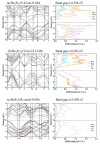First-Principles Study of High-Pressure Phase Stability and Electron Properties of Be-P Compounds
- PMID: 35161197
- PMCID: PMC8839631
- DOI: 10.3390/ma15031255
First-Principles Study of High-Pressure Phase Stability and Electron Properties of Be-P Compounds
Abstract
New, stable stoichiometries in Be-P systems are investigated up to 100 GPa by the CALYPSO structure prediction method. Along with the BeP2-I41/amd structure, we identify two novel compounds of Be3P2-P-421m and Be3P2-C2/m. It should be noted that the Be-P compounds are predicted to be energetically unfavorable above 40 GPa. As can be seen, interesting structures may be experimentally synthesizable at modest pressure. Our results indicate that at 33.2 GPa, the most stable ambient-pressure tetragonal Be3P2-P-421m transitions to the monoclinic Be3P2-C2/m structure. Moreover, the predicted Be3P2-P-421m and Be3P2-C2/m phases are energetically favored compared with the Be3P2-Ia-3 structure synthesized experimentally. Electronic structure calculations reveal that BeP2-I41/amd, Be3P2-P-421m, and Be3P2-C2/m are all semiconductors with a narrow band gap. The present findings offer insight and guidance for exploration toward further fundamental understanding and potential applications in the semiconductor field.
Keywords: first-principles; high pressure; phase transition; structural prediction.
Conflict of interest statement
The authors declare no conflict of interest.
Figures






Similar articles
-
B1-B2 phase transition mechanism and pathway of PbS under pressure.J Chem Phys. 2018 Mar 14;148(10):104503. doi: 10.1063/1.5010381. J Chem Phys. 2018. PMID: 29544306
-
First-principles prediction on the high-pressure structures of transition metal diborides (TMB2, TM = Sc, Ti, Y, Zr).Inorg Chem. 2010 Aug 2;49(15):6859-64. doi: 10.1021/ic100214v. Inorg Chem. 2010. PMID: 20578702
-
Pressure-induced phase transition, metallization and superconductivity in ZrS2.Phys Chem Chem Phys. 2018 Sep 19;20(36):23656-23663. doi: 10.1039/c8cp04271c. Phys Chem Chem Phys. 2018. PMID: 30191245
-
Phase transition and electronic properties of Co-As binary compounds at high pressure.RSC Adv. 2022 Jun 21;12(28):18102-18106. doi: 10.1039/d2ra02114e. eCollection 2022 Jun 14. RSC Adv. 2022. PMID: 35800306 Free PMC article.
-
Theoretical methods for structural phase transitions in elemental solids at extreme conditions: statics and dynamics.J Phys Condens Matter. 2022 Jul 1;34(36). doi: 10.1088/1361-648X/ac7a82. J Phys Condens Matter. 2022. PMID: 35724660 Review.
References
-
- Ohno H., Shen N.A., Matsukura F., Oiwa A., Endo A., Katsumoto S., Iye Y. (Ga, Mn) As: A new diluted magnetic semi-conductor based on GaAs. Appl. Phys. Lett. 1996;69:363–365. doi: 10.1063/1.118061. - DOI
LinkOut - more resources
Full Text Sources
Research Materials
Miscellaneous

